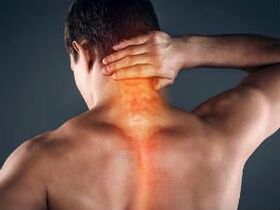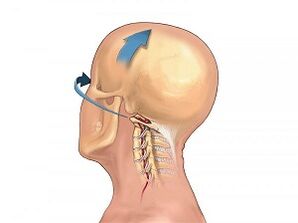
Neck osteochondrosis is a common spine disease that has patients of different ages.
It is a degenerative change in the spine plate, which develops in the background of severe stress, malnutrition, heavy physical effort and lower -level nutrition.It develops gradually, so the patient cannot immediately detect the first symptoms.
The main signs of the disease
Symptoms of cervical osteochondrosis are manifested as pathology progresses.They are more noticeable during the aggravation.After noticing the first signs of the disease, it is advisable to seek medical attention as it is often masked for other disorders, which complicates the timely diagnosis.
Patients are usually dealt with with the following complaints:
- Strong pain in the collar zone.
- Feeling of noise and congestion in the ear.
- Frequent dizziness.
- Breathing deficiency, feeling of lack of air.
- Nausea, vomiting.
- Blood pressure is swanka.
- Frequent fainting or syncopal conditions.
- It improves body temperature.
Signs of osteochondrosis of the cervix in men are not very different in women.Patients complain of the sun, the sternum, the shoulder belt.Contact your local therapist or neurologist for diagnosis.
Wearing
One of the most common symptoms of the cervical spine is cervical pain, the back of the head, the shoulder.The nature of the pain (sore, acute, light tingling) depends directly on the location of the defeat and the severity of the abnormal process.In the initial stages, this may be a slight discomfort that does not allow you to turn your head free in all directions.Gradually, the pain becomes chronic and limits the amplitude of the movements.
Pain is manifested as a result of deformation of the vertebrae due to insufficient supply of blood in the collar zone.The background of this process can be observed by cramps, anxiety and panic.The painful feeling of the neck can be given to the shoulders or arms.Strengthening after sleep, sudden movements, laughter or sneezing.The inconvenience with a characteristic crunch is combined when you turn around or try muscle weakness.
Spasating of muscle tissue and circulatory disorders often leads not only to the appearance of pain, but also to the temporary loss of the ability to move the neck.Constant overvoltage spread throughout the head and the patient begins to complain about migraine attacks.
Noise and stagnation in the ear
Cervical osteochondrosis is also manifested by ears congestion, hearing decrease and the appearance of noise.This is due to the insufficient intensity of the blood flow on the vestibular.Such a complex of symptoms is called Cochlear, but doctors are rarely associated with violation of the vertebrae.Pay attention to the nature of the noise and bells in the ear, usually increasing when a person is in a position for a long time or tries to change.
Patients deal with hearing problems of the otolaryologist.In the presence of simultaneous disorders of the state, such as the numbness of the face and the limited mobility of the neck, a neurologist is further consulted to clarify the diagnosis and to determine the cause.
Headache and migraine
The main symptoms of osteochondrosis of the cervix are rarely accompanied by the frequent appearance of headaches, and the female population is rather on them.In this area, the vertebrae are constantly exposed to overload, which leads to gradual deformation if the muscle tissue is not flexible enough to remain in a natural position.It is more difficult to identify the cause of the head pain as the symptom is not specific.
The following reasons trigger an attack:
- Cramping of the brain vessels.
- Nerve endings in the cervical spine.
- Increasing blood pressure.
- Acute violation of venous outflow.
- Increased overwork.
- Long stay in an unnatural situation.
Headache increases during the worsening and in the patient, including men.By nature, it can be constant, stupid in the form of seizures or pulsation.For older people, this symptom requires great attention as you can talk about a novice stroke, angina pectoris, heart attack or arterial hypertension.Therefore, these conditions are primarily excluded before the treatment of osteochondrosis.
Patients also complain of heart cathologies that they are in the chest area, the heart rate that allows the doctor to distinguish the condition in time.Headaches are associated with nausea and breathing difficulty and necessarily requires ECG.
Dizziness
Violation of coordination and frequent dizziness often occur when osteochondrosis develops up to 2 degrees.This is due to degenerative changes in the vertebrae, cramps and nerve endings.The brain does not receive the right amount of oxygen, which negatively affects the function of the vestibular device.
As a result of the difference in the condition of the symptom, this happens:
- Regular dizziness.These are manifested as a feeling of the whole body and the surrounding objects.Dysfunction occurs due to malfunctioning of the vestibular device, weakening of the muscle tissue and weakening of the receptors in the joints.
- Not systematic dizziness.In addition to instability, patients feel nausea attacks and an uncertain condition in an upright position.The circular rotation is usually missing.
Dizziness is a serious symptom that should be treated immediately to the doctor.In the presence of numbness of the shoulders, the paralysis of the muscle tissue of the face, the loss of awareness, and the emergency hospitalization.
Shortness of breath and lack of air
Another serious symptom with neglected osteochondrosis in the shoulder zone is a continuous feeling of air deficiency.Respiratory problems arise due to nerve endings and receptors compression that do not transmit the pulses from the pharynx to the esophagus.The shortness of breath appears by moving the vertebrae, increasing in a stressful state, accompanied by a knot on the throat wall.After taking the soothing, health returns to normal.
The lack of Air provokes rooster syndrome.The membrane cramp affects the depth and rhythm of breathing.The patient is flooded and difficult to breathe into the air, with memory problems and concentrations of attention.Such a symptom of osteochondrosis requires immediate help as it can cause many serious complications.The doctor selects the medicine separately -taking into account the condition.
Nausea
The cervical region has a large accumulation of nerve endings, with an artery responsible for transporting nutrients to the brain.Osteochondrosis gradually develops protrusion and intervertebral hernia, which affects blood pressure and, as a result, feels nausea.
Long -term violation of normal blood circulation leads to vomiting, loss of awareness, and causes stroke and disability.Therefore, the appearance of such a symptom that is not related to nutritional defects requires the doctor's immediate consultation.
Increasing blood pressure
Pressure jumps during the day can be considered a typical symptom for the cervical osteochondrosis.For a long time, no increased or reduced blood pressure is maintained, which is a typical sign of degenerative changes between the vertebrae.The daily dynamics of blood pressure are cramping because irritation of nerve endings reflex and short -term blood vessels causes cramps.
Distinguishable in the increased pressure of osteochondrosis of the cervix:
- headache;
- Discomfort in the chest;
- decrease in sensitivity in the collar zone;
- Muscle tension after a long stay in a position.
All this is taken into account when the diagnosis is made.Deeper exacerbated condition and sharp pressure drops are the basis for the patient's hospitalization and help in the hospital.
Violation of visual function
Osteochondrosis in the cervical region often causes unpleasant symptoms such as double eyes, blinking, "flies".This indicates the severity of the process and is needed for a doctor.
In the background of connective tissue destruction, such diseases can develop in the vertebrae:
- Glaucoma.The patient is diagnosed with increased intraocular pressure and optic nerve injury.Eliminating pathologists is not completely impossible, only to achieve lasting remission during complex treatment.
- Gray cataract.This abnormal process leads to the destruction of the lens.Changes involve metabolic processes and acute violation of oxygen intake.The first sign of the disease is the appearance of "flies" in mind.The start of treatment at time allows you to maintain the patient's vision.
- Claude Bernard Gornner.One of the causes of the appearance of lesion is considered hypoxia in the oxy region.The main signs of the pathological state are different from the reduction of the learner's reaction or the difference in the size of the learner in different eyes.Some patients complain that they can't completely close their eyes to night rest, and Twilight Vision also suffers.
The ophthalmologist prescribes treatment after a thorough examination.However, therapy is carried out only in a complex aimed at eliminating the cause of the infringement.Only in this case is it can effectively cope with the problem.
Greenish problems
Degenerative changes in the cervical vertebrae cause swallowing problems.The patient complains about who in the throat, the sore, the feeling of a foreign body of the throat, itching.Signs indicate that they violate the work of neuromuscular packages from the spinal cord.However, symptoms are not considered characteristic and can be observed with abnormal disorders such as inflammation, tumor.
A change in body temperature

Osteochondrosis, as it progresses, causes an increase in body temperature.Such symptoms occur when the spinal artery damage, the spinal canal stenosis or the disc rise.Provokes changes in neurosis and related neurological disorders.
In the background of temperature growth, numbness of the tongue or hands, the inflammatory process of the lymph nodes, the burning feeling of the tongue.
Suspicion of osteochondrosis allows the characteristic crunch when the neck is rotated.
Symptoms of osteochondrosis depending on the stage
Signs of osteochondrosis of the cervical spine are highly dependent on the development of pathology, the development of compression forces of nerve endings and the deformation of the plate.It provokes the appearance of symptoms by tightening the spinal artery and violation of the bloodstream of the brain.The pinching of nerve endings leads to severe neurological pathologies.
The severity of the signs depends directly on the stage of the disease:
- Initial.The patient continues the degenerative processes of vertebrates unnoticed.It is quite difficult to notice the first changes as it can be a light headache (felt stronger than women), cervical discomfort, slight deterioration of vision, or loss of sensitivity to the collar zone.At this stage, patients rarely go to a doctor, attributable to fatigue, lack of sleep or stress.
- The second stage.As the pathology progresses and the appearance of discs, there are more prominent symptoms.The destruction of the fibrous ring affects the movement of the head and becomes more limited.Patients complain of continuous ringing of ears, impaired visual function, cervical pain, characteristic crackling, swallowing problems, sleep disorders and reduction of reflex clarity.Keeping the head in a situation causes serious discomfort, which requires a doctor's consultation.
- The third stage.The intervertebral hernia gradually develops, the fibrous ring is completely destroyed, the deformation of the vertebrae, the displacement of the bone segment, dislocations, instability.The patient complains of acute pain in cervical pain, expressed shoulder syndrome, paralysis of the upper limbs, and reflexes of tendons cannot be observed, and the sensitivity of the scalp is impaired.This is a serious stage of the disease that requires complex treatment.
Osteochondrosis is a chronic systemic disease showed by various symptoms.The reason for this is always hidden in suppressed nerve endings, circulatory disorders, and deformation of intervertebral discs.Protests, hernia and displacement gradually lead to loss of vertebral mobility.
Age directly affects the severity of the symptoms.The older the patient, the stronger the changes in bond and bone tissues.This is due to the weakness of muscle fiber, the lack of nutrients, and chronic inflammatory diseases.
A review of patients
Osteocondrosis of the cervical vertebrae is a common disease because nerve roots are constantly sensitive to the load on excessive mobility of the segment.Timely recognition of pathology allows you to avoid serious complications, so many people read patients and compare them with symptoms.
It is strictly forbidden to diagnose yourself without laboratory and hardware research.All information should only be taken into account.
The cervical osteochondrosis is declared with a number of symptoms, but most of them are easy to confuse with similar pathologies.Therefore, it is advisable to consider the patient's complaints in the complex and to perform differential diagnosis that allows the disease to determine the disease in time and the correct treatment, which includes physiotherapy, gymnastics and medication.

























